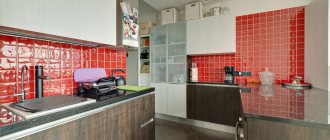The free layout of an apartment in a new building is constantly included in the list of advantages especially highlighted by the developer. But such a solution may turn out to be far from the most profitable from a financial point of view and can lead to problems after purchasing an apartment or apartment. To begin with, you should clarify what an open plan is, what it means in words, in deeds and in documents.
The description of apartments in new buildings on official websites is advertising information in which the developer is free to indicate as advantages what he considers necessary. But there are construction and design standards and rules for housing registration. Let’s make a reservation right away - there is no concept of “free layout” in SNiP and GOST. This is an exclusively commercial, advertising name for one of the types of zoning of residential space.
Features of open-plan apartments and apartments
The absence of partitions or the so-called conditional “tracing” of the internal walls in the apartment are two options for implementing an open plan. In fact, it has many more features that are worth remembering when choosing this solution.
Main features of open-plan apartments and apartments:
- lack of full internal partitions;
- the possibility of implementation only under certain conditions, in buildings built using monolithic technology , where the external walls and frame columns are load-bearing;
- the presence of “wet zones” that are strictly assigned to their places;
- lack of finishing of walls, floors and ceilings, since it is assumed that this will be done after the installation of partitions.
These are visible features, but there is also something that is implied but not voiced by the developer. The fact is that an open plan does not provide complete freedom to organize space, and in some cases becomes a source of additional costs. Let's look at this separately and in detail.
Layout is the most important design stage
The functionality of the future home is laid out during the development of the project, which includes the layout of the internal space. It displays the location of load-bearing and enclosing structures, partitions, windows and doors, as well as:
- the overall size of the house, its positioning relative to the cardinal directions;
- number of floors, their altitude location with indication of marks;
- area and geometric dimensions of all premises;
- building material used during construction;
- location of utility networks and life support equipment.
A rational layout inside the house allows you to take into account the interests of each family member and allocate personal space for each.
Free layout and its pitfalls
When studying the documentation and design declaration of a new building, you will not find direct mention of an open plan, since such a term does not exist. Most likely, the developer will indicate the possibility of routing partitions or stipulate their absence. But the design of any building implies the inclusion of floor plans in the documentation, which is very important for the buyer.
Floor plan of a new building with an open plan
The floor plan of a residential building or apart-hotel includes all the partitions and walls that are included in the project. It is according to this plan that the BTI draws up a technical passport of the building, and then of your apartment, so that you can register it as your property. Therefore, when you come across a mention of an open plan, demand to show you these plans - you may well see the partitions already marked there. And their location can only be changed during the redevelopment process, and this means the creation and approval of a separate project. If a routing has already been laid around the apartment, then the partitions are placed only along it.
Floor plan without partitions
The second option is that there are no partitions in the floor plan. This means that the room has residential status as a single space, in which “wet zones” are designated, but there are no precisely indicated boundaries of the bathroom, kitchen, corridor and hallway. If you think that this simplifies the situation, then you are very mistaken, because:
- when installing partitions, it is necessary to strictly maintain the dimensions of wet areas, otherwise, by increasing the bathroom or kitchen, you are reducing the living space, which is equivalent to redevelopment - project, approval;
- you will have to coordinate the redevelopment or resort to the services of a developer if he is ready to take it upon himself, because a corridor should appear in the apartment, and the bathroom can only be enlarged due to this space;
- you cannot in any way block approaches or disrupt the configuration of ventilation and cable ducts, or move “wet areas”;
- you must install partitions so that the living rooms have an area of at least 9 square meters and must have a source of natural light, a window, access to a balcony or loggia;
- It is not allowed to combine balconies, loggias and room spaces, or to expand the heating network to these parts of the apartment.
It is also worth thinking about the fact that after installing the internal non-load-bearing walls, you will have to lay the wiring, which means creating a project for it and again going for approval. In short, there is very little freedom in an open plan, and its pros and cons are often completely ignored by the developer.
Ideal layout rules
In order for a new house to meet the expectations of all household members and make a favorable impression on guests, you should adhere to certain rules when designing it, especially if you yourself are thinking about the future arrangement of the rooms. We invite you to familiarize yourself with the most useful recommendations that will help you develop a competent plan.
1. The most suitable shape for any room is square, and the acceptable width of the room is 3 m. A rectangular shape is also allowed, but provided that the aspect ratio of 3:4 is maintained. Long and narrow living rooms will be inconvenient for comfortable living and will make it difficult to place furniture appropriately. Example of a house plan with square rooms:
2. For small houses, an excellent solution would be to combine the hallway with the living room.
You can attach a small vestibule in front of the entrance - this will allow you to avoid large numbers of insects entering the house in summer, and cold in winter. Look at an interesting solution for a narrow Bavaria frame house.
3. The hallway should be of such a size that 3-4 people simultaneously on its territory feel comfortable and free. An example of the layout of a house with an entrance hall (vestibule) with an area of 7 m2:
4. Access to the technical premises should be planned from the street, and it is desirable that the door opens outward (see plan above).
5. When considering the design of your future home, you should consider the features of daylighting. Design the layout of the rooms relative to the position of the sun. There should be enough natural light to move around the house during the day. This will save on electricity. Also, keep in mind that the light should fall on the desktop for left-handed people from the right side, and for right-handed people - from the left. Example of a daylight irradiance map:
If you make a mistake with this point, reconstruction will help.
6. You should not save on the space of the bathroom and kitchen, otherwise being in them will cause discomfort. The kitchen should be located taking into account plumbing communications, closer to the bathroom. It is also necessary to think about a good ventilation system in advance. An example of the correct location of bathrooms and kitchens in a two-story house:
Pay attention to the option of locating the plumbing riser in the center of the house - this way you can change the layout frequently and radically, add bathrooms and wet points without additional risers and a large number of pipes. The premises will look very modern.
7. The parent's bedroom should be spacious. As a rule, it provides for a dressing room, a private bathroom, an equipped place to work, a place for a TV and, if necessary, a computer. If the house is small, the dressing room can be replaced with a wardrobe.
8. It is best to provide a separate room for each child, especially if there is a big age difference between them or they are of different genders.
9. It is worth reducing the number of corridors, since they take up useful space, which may not be enough in a house with small dimensions. In addition, the fewer there are, the more convenient it will be to move around the house. An example of a house layout with a minimum number of corridors: 10. It is necessary to provide a ventilation system not only in the kitchen, but also in the bathroom and toilet. This is a must for modern homes.
11. Bedrooms should be located separately from other rooms, especially noisy ones. It is best to position the windows so that they face east. This will make the room bright and avoid overheating in the summer.
12. If you need to install a staircase in a small room, it is better to opt for a multi-span or spiral design.
For mini-houses and country houses, a regular ladder may be suitable.
13. It is best to plan a pantry for food supplies, canned food and kitchen equipment near the kitchen.
The most suitable places for a dressing room are the bedroom or the hall/living room.
14. In order for family members to feel cozy and comfortable in the house, it is necessary to provide each of them with a sleeping place and at the same time a working place where they can be alone. This can be either an isolated area or a separate room. In addition, you should definitely provide a place for a common room in which household members can gather and communicate.
15. If you plan to build an open or closed veranda, terrace or attic, when choosing a place for them, you should take into account that they are located on the sunny side and are protected from the wind. Only compliance with these conditions will ensure a comfortable stay at any time of the year. An example of the layout of a house with a terrace and veranda:
16. It is advisable to think in advance about the location of bulky and obligatory furniture. This will allow you to rationally use the space of the rooms and calculate their optimal size.
17. The most suitable height of standard ceilings is 3 m. Too low ones cause a feeling of compressed space and many may feel uncomfortable and constrained. A room with high ceilings will require greater construction and furnishing costs, and will also increase the cost of heating. Loft ceilings under the roof are now becoming popular, the fashion for which was introduced by barnhouses.
18. There are two ways to draw up a plan for a cozy “family nest”.
First: determine the optimal size of the house relative to the area of the land and fill the interior space with various rooms.
Second: first decide which rooms will be located in the house, and then, based on their shape, size and location, draw the boundaries of the residential building.
You can draw a preliminary sketch yourself using the computer-aided design and drawing system AutoCAD.
Third: among ready-made house designs, find “the one” that suits you, or one that you generally like, but requires minor changes. We recommend it. 19. For a small plot of land, it is advisable to develop a project for a two-story (or 1st floor + attic) house. Downstairs there are usually common and utility areas (living room, dining room, kitchen, boiler room, laundry room), and upstairs there is a private bedroom area. Check out the Vaala house project.
Costs and approvals for open planning
It is also worth remembering the costs. If the floor plan and layout of the apartment (apartments) indicate the locations of the partitions, then you are actually taking upon yourself to pay for what the developer did not do - the installation of internal walls. At the same time, your freedom is minimal, and any change requires approval. Considering that an open plan usually serves as a reason for an increase in the price of an apartment, the advantage looks dubious.
The second option is redevelopment of a single room. This is still justified, since you can choose options that do not violate building codes. If the approval is successful, if the developer is ready to take it upon himself, then investing in comfort is worth it. However, we must not forget about the restrictions listed above.
Features of individual rooms
Every place needs to be properly lit. Agree, the baby will be pleased when the sun peeks into the nursery during the day, and at night the moon and stars make him happy. It is the children's room that should be the brightest room and, by the way, the quietest. In general, it is better to have windows in each room facing two or three cardinal directions. If you like a lot of natural light, choose a room on the “west-east” axis, then the room will be light all the time.
It is worth considering the living room separately. It can be of almost any size - even up to one hundred square meters, this is determined only by the desires and capabilities of the future owners. But usually they still make it smaller.
For a bedroom, a comfortable area will be fifteen to eighteen meters. Bedrooms should be placed in remote parts of the apartment, with windows facing the courtyard. You should be very careful when arranging your kitchen. You need to conveniently place all the equipment needed for cooking and not only and plan how it will be convenient for people to walk around it (especially if another person is cooking in the kitchen at the same time). Most often, kitchens are now made with the following layouts: something like the letter L, something like the letter U, double-row and single-row. But with each of them, zones are created so-called. work triangle. If placed correctly, its perimeter will be minimal, and moving around the kitchen will be easy and pleasant. Some time ago, a toilet combined with a bathroom was considered more of a disadvantage than an advantage. However, later practice showed that combining them is still more convenient and hygienic than vice versa. Even if the bathroom is extremely large, the owners do not always want to make the toilet separate. According to generally accepted and reasonable rules, the door should open inward, the washbasin and mirror should be immediately visible. Since this is not easy to achieve in a small bathroom, you can still sometimes allow the door to be opened from the outside. The sink should be located closer to the bathroom, the toilet close to the sewer pipe.
How to legitimize and approve redevelopment in a new building
What to do if for some reason you have already installed partitions or changed the original floor plans and layout? You will have to conduct a construction and technical examination, obtain a conclusion that norms and standards have not been violated, and go to court to legalize the redevelopment.
What happens if you ignore the agreement? Firstly, the BTI may not issue a registration certificate, and registration of ownership of the apartment will fail. Secondly, the court may rule on the forced restoration of the apartment to its original condition at the expense of the owner. It is expensive.
So, even at the stage of choosing a new building, you should think about whether you are ready for additional costs and hassle. associated with an open plan. Its advantages and disadvantages may not be in balance at all, and the developer’s promises are a completely acceptable advertising technique, the exercise of his right to draw your attention to the property for sale.
Help from specialists
Truly professional and highly paid craftsmen will carry out the layout of the apartment using the appropriate special programs.
For example, they will create a three-dimensional model in 3D Max, and later, in order to obtain drawings, they will transfer it to AutoCAD or ArchiCAD. This is the stage to which it is worth moving on when the entire theory has already been completed and the practical implementation of the conceived ideas will soon begin.
How to distinguish a good layout from a bad one
What should you focus on when analyzing a project produced by a designer?
There are not many recommendations regarding proper planning. The main ones are:
- Dividing space into zones with different purposes.
- Axial symmetry.
- The “follow the red” principle.
It is possible to show how these rules work only in a large area.
One example of zoning space with color and partitions
Do I need to register?
In legal practice there is no term “open plan”. Therefore, work on redevelopment of this type of housing should be recorded in BTI documents.
The legislation provides for mandatory requirements for work related to changing the structure of apartments. First of all, they concern measures for safe cohabitation. The Housing Code of the Russian Federation dated December 29, 2004 N 188-FZ spells out all the relevant requirements. Developers may claim that free redevelopment does not require approval and confirmation by the BTI, but they are wrong.
Design options
The choice of style depends less on the layout and more on the taste of the owners. However, certain design directions in free space will look best:
Loft. Since the industrial style originated in abandoned industrial buildings, an open, solid room is just about it. If you add high ceilings and large windows to the free planning area, you get the ideal basis for a loft.
Minimalism. The multifunctionality of the main room (kitchen-living room) requires the presence of a large number of things. To avoid visual noise, embody modern minimalism with few accents.
The photo shows a two-level apartment
Art Deco. Luxurious finishes and furniture love large areas. Suitable for lovers of discreet classics and exaggerated baroque.
An open-plan apartment can be both a blessing and a punishment: but if you are ready for all the “surprises” and restrictions, then you won’t find better housing!
Typical mistakes in the layout of private houses
As practice shows, when planning a house and its interior, mistakes are made that complicate subsequent operation. These include:
- incorrect location of a village or country house on the site;
- making spontaneous adjustments to an existing project during construction;
- installation of glazing over an unreasonably large area;
- placement of wet areas away from utilities, which leads to an increase in the length of pipelines, raising floors (reducing ceiling height);
- installation in rooms without natural light in living rooms or kitchens;
- lack of an entrance hall, hall, and some utility areas;
- placing a bathroom for guests away from the entrance;
- adopting the wrong slope for stairs leading to an upper floor or attic.
Geodetic work on vertical planning
A vertical layout geodesy project is developed by specialists from a design firm. There are two main types of vertical planning project development.
- Design of a horizontal territory while maintaining the balance of earth masses.
- Design of inclined platforms.
Earth mass balance is a condition under which the difference between the volumes of cutting and adding soil should be as close to zero as possible.
If the volume of soil extracted during the development of excavations can be placed without any residue in an embankment erected at a construction site, then the balance is called zero.
This option can be called optimal, since it will not require additional costs for soil development, loading and transportation.
When designing, the existing topographic surface of the construction site is taken as a basis. In general, the simplest and most common method is the following.
A geodetic survey (leveling) of the construction site is carried out using a grid of squares. The length of the side of the square is taken from 10 to 100 meters.
The tops of the squares are marked on the ground with pegs. Based on a topographic survey of the elevations of the tops of the squares, the design elevation of the planned (horizontal) construction site is calculated.
Then the working marks of the intersections of the squares are calculated (plus - add, minus - cut), as well as the position of the places and lines of zero work. After this, the volumes and cartogram of the earth masses are calculated.
A similar technique is used when designing inclined platforms. The vertical layout of the construction site is carried out taking into account the slope specified by the project.
Check the division of space into functional zones
Focus on the distribution of functional areas. Every home has private areas.
The first category includes rooms in which residents spend time during the day and receive guests. This is a living room with a kitchen, a study. Some people are also setting up a library in their homes.
The private zone includes bedrooms, adjacent dressing rooms and bathrooms, and gyms. These are rooms that guests do not usually enter.
The bedroom on the second floor is a private area
It is recommended to separate private and public areas into different parts of the building. At the planning stage, make sure that the entrance to the office does not lead from the bedroom, and the bathroom is not located in the center of the living area. Scroll through possible scenarios for receiving guests in your head. Could they accidentally end up in the wrong room instead of the toilet? Won't a sleepy child have to go to the bathroom at night through the living room where you were hanging out with friends?
Another not very convenient option is a dressing room located in a remote part of the house, and not next to the bedroom. To get there, you have to cross the entire building. Think twice before setting up a dressing room, for example, in the basement.
In the spacious house you can conveniently organize life for all residents.
What to remember
An apartment with free redevelopment can bring unnecessary problems to the owners. However, the redevelopment in it should be formalized according to the law - this will allow you to get an apartment after the renovation, which you can safely sell, donate or inherit.
Before dealing with documents, you should contact redevelopment specialists, for example, us. An incorrect first step can greatly complicate the coordination work and even make it impossible.
We will tell you what can be agreed upon in apartments with free redevelopment, even if you do not have BTI documents for the apartment, and what needs to be done for this.
Leave a request for a free consultation on apartment redevelopment
Zamyatin Dmitry Alekseevich
Zamyatin Dmitry Alekseevich
General Director of LLC "APM-1" Design workshop PEREPLAN.
Education: Higher technical (Master's degree from Moscow State University of Civil Engineering)
Specialization Coordination of redevelopment of commercial and residential real estate in Moscow and St. Petersburg










